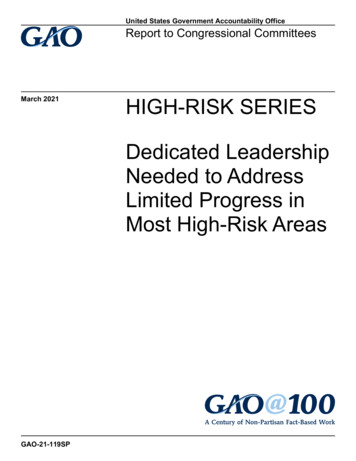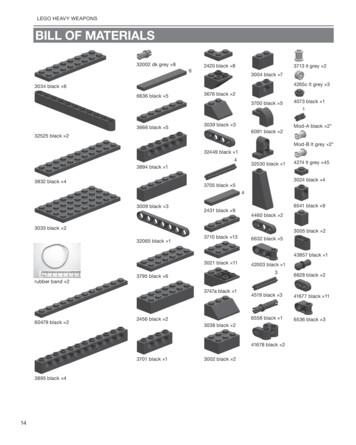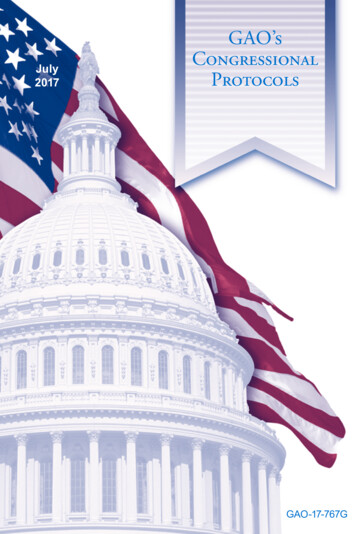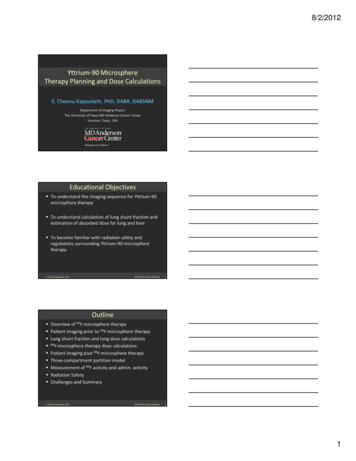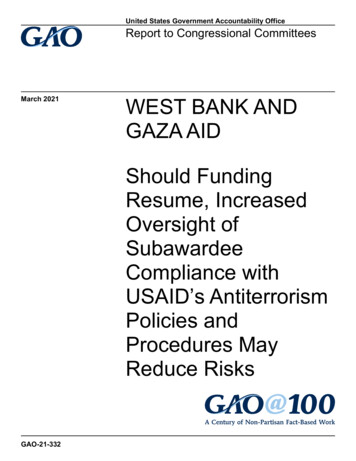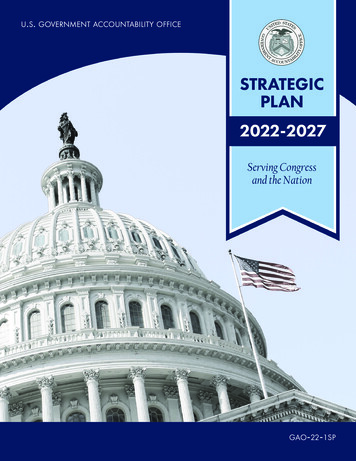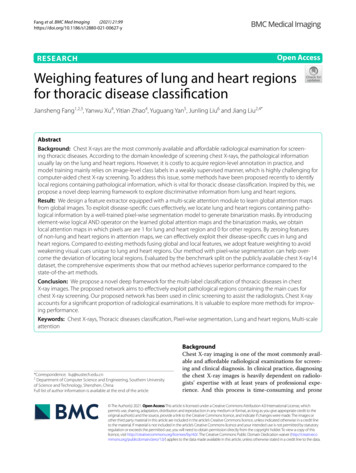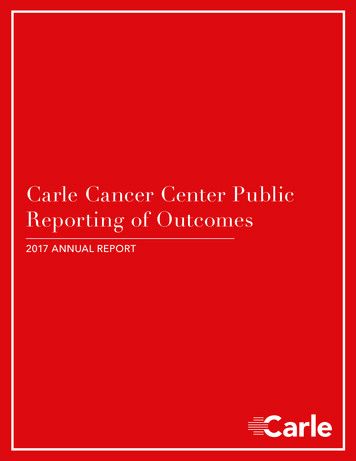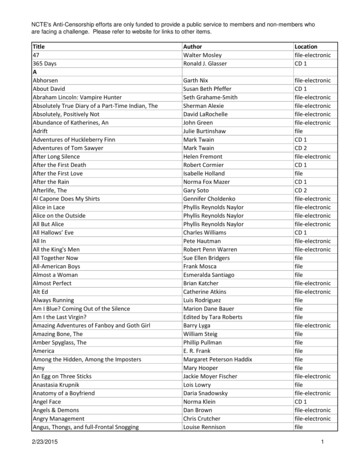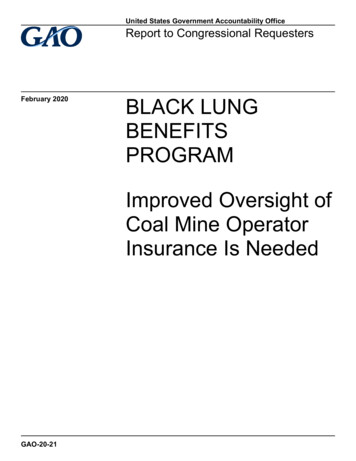
Transcription
United States Government Accountability OfficeReport to Congressional RequestersFebruary 2020BLACK LUNGBENEFITSPROGRAMImproved Oversight ofCoal Mine OperatorInsurance Is NeededGAO-20-21
February 2020BLACK LUNG BENEFITS PROGRAMImproved Oversight of Coal Mine Operator InsuranceIs NeededHighlights of GAO-20-21, a report tocongressional requestersWhy GAO Did This StudyWhat GAO FoundIn May 2018, GAO reported that theTrust Fund, which pays benefits tocertain coal miners, faced financialchallenges. The Trust Fund hasborrowed from the U.S. Treasury’sgeneral fund almost every year since1979 to make needed expenditures.GAO’s June 2019 testimony includedpreliminary observations that coaloperator bankruptcies were furtherstraining Trust Fund finances because,in some cases, benefit responsibilitywas transferred to the Trust Fund.Coal mine operator bankruptcies have led to the transfer of about 865 million inestimated benefit responsibility to the federal government’s Black Lung DisabilityTrust Fund (Trust Fund), according to DOL estimates. The Trust Fund paysbenefits when no responsible operator is identified, or when the liable operatordoes not pay. GAO previously testified in June 2019 that it had identified threebankrupt, self-insured operators for which benefit responsibility was transferredto the Trust Fund. Since that time, DOL’s estimate of the transferred benefitresponsibility has grown—from a prior range of 313 million to 325 million to themore recent 865 million estimate provided to GAO in January 2020. Accordingto DOL, this escalation was due, in part, to recent increases in black lung benefitaward rates and higher medical treatment costs, and to an underestimate ofPatriot Coal’s future benefit claims.This report examines (1) how coal mineoperator bankruptcies have affected theTrust Fund, and (2) how DOL managedcoal mine operator insurance to limitfinancial risk to the Trust Fund. GAOidentified coal operators that filed forbankruptcy from 2014 through 2016using Bloomberg data. GAO selectedthese years, in part, becausebankruptcies were more likely to beresolved so that their effects on theTrust Fund could be assessed. GAOanalyzed information on commerciallyinsured and self-insured coal operators,and examined workers’ compensationinsurance practices in four of thenation’s top five coal producing states.GAO also interviewed DOL officials,coal mine operators, and insurancecompany representatives, amongothers.Self-Insured Coal Mine Operator Bankruptcies Affecting the Black Lung DisabilityTrust Fund, Filed from 2014 through 2016What GAO RecommendsGAO is making three recommendationsto DOL to establish procedures for selfinsurance renewals and coal operatorappeals, and to develop a process tomonitor whether commercially-insuredoperators maintain adequate andcontinuous coverage. DOL agreed withour recommendations.View GAO-20-21. For more information,contact Cindy Brown Barnes (202) 512-7215,brownbarnesc@gao.gov, or Alicia PuenteCackley (202) 512-8678, cackleya@gao.gov.Amount ofcollateral at timeof bankruptcyEstimated transferof benefitresponsibility tothe Trust FundEstimated numberof beneficiaries forwhom liability hasbeen transferred tothe Trust FundAlpha NaturalResources 12 million 494 million1,839James River Coal 0.4 million 141 million490Patriot Coal 15 million 230 million993 27.4 million 865 million3,322Coal operatorTotalSource: Department of Labor (DOL). GAO-20-21DOL’s limited oversight of coal mine operator insurance has exposed the TrustFund to financial risk, though recent changes, if implemented effectively, canhelp address these risks. In overseeing self-insurance in the past, DOL did notestimate future benefit liability when setting the amount of collateral required toself-insure; regularly review operators to assess whether the required amount ofcollateral should change; or always take action to protect the Trust Fund byrevoking an operator’s ability to self-insure as appropriate. In July 2019, DOLbegan implementing a new self-insurance process that could help address pastdeficiencies in estimating collateral and regularly reviewing self-insuredoperators. However, DOL’s new process still lacks procedures for its plannedannual renewal of self-insured operators and for resolving coal operator appealsshould operators dispute DOL collateral requirements. This could hinder DOLfrom revoking an operator’s ability to self-insure should they not comply with DOLrequirements. Further, for those operators that do not self-insure, DOL does notmonitor them to ensure they maintain adequate and continuous commercialcoverage as appropriate. As a result, the Trust Fund may in some instancesassume responsibility for paying benefits that otherwise would have been paid byan insurer.United States Government Accountability Office
ContentsLetter1BackgroundSome Self-Insured Operator Bankruptcies Shifted Liability to theTrust Fund, but Commercial Insurance Coverage Can HelpLimit Trust Fund ExposureDOL’s Limited Oversight Has Exposed the Trust Fund to FinancialRisk, and Its New Self-Insurance Process Lacks EnforcementProceduresConclusionsRecommendations for Executive ActionAgency Comments and Our Evaluation61118272828Appendix IComments from the U.S. Department of Labor31Appendix IIGAO Contact and Staff Acknowledgments33TablesTable 1: Self-Insured Coal Mine Operator Bankruptcies ThatAffected the Black Lung Disability Trust Fund, Filed from2014 through 2016Table 2: Self-Insured Coal Mine Operator Reauthorization Date,Collateral, and Estimated Benefit Liability Under DOL’sFormer Self-Insurance Process1319FiguresFigure 1: Black Lung Beneficiaries, Fiscal Years 1979 through2019Figure 2: Most Common Reasons Black Lung Benefits May BePaid from the Black Lung Disability Trust FundFigure 3: Coal Mine Operator Bankruptcies Filed from 2014through 2016Page i7912GAO-20-21 Black Lung Benefits Program
efits Review BoardU.S. Department of LaborU.S. Department of the TreasuryNational Council on Compensation InsuranceNational Institute for Occupational Safety and HealthOffice of Administrative Law JudgesOffice of Workers’ Compensation ProgramsU.S. Energy Information AdministrationThis is a work of the U.S. government and is not subject to copyright protection in theUnited States. The published product may be reproduced and distributed in its entiretywithout further permission from GAO. However, because this work may containcopyrighted images or other material, permission from the copyright holder may benecessary if you wish to reproduce this material separately.Page iiGAO-20-21 Black Lung Benefits Program
Letter441 G St. N.W.Washington, DC 20548February 21, 2020The Honorable Robert C. “Bobby” ScottChairmanCommittee on Education and LaborHouse of RepresentativesThe Honorable Richard E. NealChairmanCommittee on Ways and MeansHouse of RepresentativesThe federal government’s Black Lung Disability Trust Fund (Trust Fund)finances medical and cash assistance to certain coal miners who havebeen totally disabled due to pneumoconiosis (also known as black lungdisease). 1 Black lung benefits are generally to be paid by responsible coalmine operators. However, the Trust Fund pays benefits in certaincircumstances, including in cases where no responsible mine operatorcan be identified or when the liable mine operator does not pay.As we reported in May 2018, the Trust Fund faces financial challenges. 2Its expenditures have consistently exceeded revenue and the Trust Fundhas essentially borrowed with interest from the Department of theTreasury’s (Treasury) general fund almost every year since 1979, whichwas its first complete fiscal year. 3 In fiscal year 2019, the Trust Fund1Aminer’s surviving dependents can also receive compensation. Black lung is caused bybreathing coal mine dust, and the severity of the disease can range from mild—with nonoticeable effects on breathing—to advanced disease, which could lead to respiratoryfailure and death according to the Department of Health and Human Service’s Centers forDisease Control, National Institute for Occupational Safety and Health. .html.2GAO,Black Lung Benefits Program: Options for Improving Trust Fund Finances,GAO-18-351 (Washington D.C.: May 30, 2018).3Underfederal law, when necessary for the Trust Fund to make relevant expenditures,funds are appropriated to the Trust Fund as “repayable advances,” and then thoseadvances must be repaid with interest to the general fund of the Treasury. 26 U.S.C. §9501(c). For reporting purposes, we refer to this process as “borrowing” from Treasury’sgeneral fund, which is distinct from the borrowing authority provided by law to someagencies. According to the Treasury, the general fund includes assets and liabilities usedto finance the daily and long-term operations of the U.S. government as a whole.Page 1GAO-20-21 Black Lung Benefits Program
borrowed about 1.9 billion to cover its expenditures, according toDepartment of Labor (DOL) officials.Trust Fund revenue is primarily obtained through a tax on coal producedand sold domestically, which we refer to in this report as the coal tax. 4The coal tax rate has varied over the years. From 1986 through 2018, thecoal tax rate was 1.10 per ton of underground-mined coal and 0.55 perton of surface-mined coal, up to 4.4 percent of the sales price. In 2019,the rate of the coal tax decreased to 0.50 cents and 0.25 cents per tonof underground-mined and surface-mined coal, respectively, up to 2percent of the sales price. In 2020, the rate of the coal tax increased topre-2019 levels. However, it is scheduled to decrease again beginning in2021. With less revenue from the coal tax, the Trust Fund will likely needto borrow more from Treasury’s general fund, and taxpayers willultimately be responsible for repaying this accumulating debt.In June 2019, we reported preliminary observations that coal operatorbankruptcies were further straining Trust Fund finances because, in somecases, responsibility for benefit payments was transferred from thebankrupt operator to the Trust Fund. 5 This may occur, for instance, whenthe amount of collateral DOL requires from a self-insured coal operatordoes not fully cover the operator’s benefit responsibility should theoperator become insolvent.This report examines (1) how coal mine operator bankruptcies haveaffected the Trust Fund, and (2) how DOL managed coal mine operatorinsurance to limit financial risk to the Trust Fund. To address bothobjectives, we reviewed relevant federal laws, regulations, and DOLprocedures. We also interviewed DOL officials, coal mine operators, andinsurance company representatives. Additionally, we interviewed officialsfrom the National Mining Association, National Council on CompensationInsurance (NCCI), National Council of Self-Insurers, and the AmericanAcademy of Actuaries, among others.To assess how coal mine operator bankruptcies affected the Trust Fund,we analyzed Bloomberg Terminal (Bloomberg) data and consulted DOL4Thecoal tax is imposed on the sale of all domestically produced coal with twoexceptions: (1) lignite coal and (2) exported coal.5GAO,Black Lung Benefits Program: Financing and Oversight Challenges Are AdverselyAffecting the Trust Fund, GAO-19-622T (Washington D.C.: June 20, 2019).Page 2GAO-20-21 Black Lung Benefits Program
to identify coal operators that filed for bankruptcy from 2014 through2016, and whose cases had progressed far enough such that theoutcome (or likely outcome) was known. During these years, domesticcoal production declined from about 1 billion tons in 2014 to about 728million tons in 2016, which was the lowest annual production level since1978, according to U.S. Energy Information Administration (EIA) data. 6Additionally, bankruptcies filed during these years were more likely to beresolved at the time we conducted our work than more recently filedbankruptcies, so their effects on the Trust Fund could be assessed. 7 Weidentified eight coal mine companies that filed for bankruptcy during ourselected years. 8 To assess the reliability of the Bloomberg data, weinterviewed Bloomberg officials and reviewed relevant systemdocumentation. In addition, to assess the completeness of the Bloombergdata, we conducted a limited legal search for bankruptcy filings andverified our results with DOL. We determined that the data weresufficiently reliable for the purposes of this report. To examine how eachof the eight coal mine operator bankruptcies affected the Trust Fund, weinterviewed DOL officials and reviewed DOL-provided documentation. Forinstance, we reviewed bankruptcy settlement agreements andreorganization plans, where applicable. We did not conduct a legalanalysis of the relevant bankruptcy court dockets, and relied solely ondocumentation DOL provided to describe these bankruptcies.To examine how DOL managed coal mine operator insurance to limitfinancial risk to the Trust Fund, we analyzed data and documentation oncommercially-insured and self-insured coal mine operators. Specifically,we reviewed NCCI data on the commercial workers’ compensationinsurance policies purchased by coal mine operators to secure their blacklung benefit liability from 2016 through 2018, the most recent threecomplete years of data available. 9 We reviewed the data to identify,among other things, whether operators had lapses in coverage.6EIA,Annual Coal Report 2018 (Washington D.C.: October 2019).7Bankruptcies proceedings can vary in duration. We identified coal mine operatorbankruptcies that were filed from 2014 through 2016 because they were more likely to beresolved. Bankruptcies filed more recently may still be ongoing and their effects on theTrust Fund may not yet be known.8Oursearch focused on the bankruptcies of parent operators rather than individualsubsidiaries.9NCCIofficials said that once they transmit data to DOL it effectively becomes DOL data.Therefore, for reporting purposes, we will refer to this data as DOL data.Page 3GAO-20-21 Black Lung Benefits Program
Specifically, we verified whether the 13 largest coal producers that werenot authorized to self-insure maintained adequate and continuouscommercial coverage during these years. 10 We also reviewed DOLdocumentation on each of the 22 coal mine operators that were selfinsured at the time we conducted our work. 11 For instance, we identifiedthe amount of collateral DOL required from these operators to self-insureand DOL’s most recent reauthorization memo that documented itsperiodic review of these operators.We assessed the reliability of the NCCI data in several ways. Specifically,we interviewed DOL and NCCI officials on how policy data is obtained,processed, stored, and shared; reviewed documentation including a datadictionary and users guide; reviewed DOL’s procedures and error checksfor validating that the NCCI data conforms to established parameters; andreviewed the data for obvious errors, outliers, or missing information andfor logical connections between policy and endorsement data. Wedetermined that the data were sufficiently reliable for the purposes of thisreport. However, we concluded that the beneficiary data we reviewed inan attempt to determine the extent to which the Trust Fund paid benefitsduring fiscal year 2018 on behalf of uninsured operators were notsufficiently complete and consistently recorded. Thus, we were unable toassess the effect on the Trust Fund of DOL not monitoring coal operatorcompliance with commercial insurance requirements. This condition andits causes are further described in the report, which form the basis for oneof our recommendations.We also examined workers’ compensation insurance practices in fourstates—Kentucky, Pennsylvania, West Virginia, and Wyoming—to identifyrelevant practices that could inform DOL’s administration of coal operatorinsurance at the federal level. Such practices may be informative becauseboth workers’ compensation and federal black lung disability paymentsgenerally support workers with conditions, such as black lung, that werecontracted as a result of their employment. Workers’ compensation is10Thecoal operators represented approximately 25 percent of all coal produced in 2017.See EIA, Annual Coal Report 2017 (Washington D.C.: November 2018).11The self-insured arrangements can include those that cover legacy federal black lungliabilities (e.g., formerly employed miners only). This may arise when an operator nolonger actively mines coal, owns subsidiaries that no longer actively mine coal, or is usingcommercial insurance for its current mining operations and self-insurance for its pastoperations. Self-insured operators and their subsidiaries may use a combination of selfinsurance and commercial insurance to cover their liabilities, according to DOL.Page 4GAO-20-21 Black Lung Benefits Program
generally mandated by state law and employers are typically required topurchase workers’ compensation insurance to secure these liabilities, ormay self-insure. 12 Thus, state practices in monitoring and overseeingworkers’ compensation insurance may provide informative context forexamining DOL’s practices in overseeing federal black lung insurance.To review state practices for monitoring and overseeing workers’compensation insurance, we interviewed state insurance commissionersand reviewed selected workers’ compensation laws, regulations, andguidance in the four states we contacted. We selected Kentucky,Pennsylvania, West Virginia, and Wyoming because they were amongthe top five coal producing states in 2017, according to EIA data, andtherefore may be most familiar with workers’ compensation insurance thatcovers black lung. Additionally, these states provided geographicvariation covering EIA’s three main domestic coal producing regions: theAppalachian coal region, the Interior coal region, and the Western coalregion. Kentucky is divided between EIA’s Appalachian and Interior coalregions. These states also provided variation in terms of the optionsavailable to coal mine operators to secure their workers’ compensationbenefit liability. For instance, with the exception of Wyoming, all selectedstates allowed operators to self-insure. In Wyoming, coal mining isconsidered an “extra-hazardous” occupation and mine operators mustpurchase workers’ compensation insurance from a state-provided option.In our selected states, we obtained information on, among other things,state practices for determining the amount of collateral required from coalmine operators to self-insure their workers’ compensation benefitliabilities, if applicable. We also obtained information about the extent towhich state officials reviewed self-insured coal mine operators to assesswhether the amount of collateral they required changed based on anoperator’s changing financial condition.We conducted this performance audit from May 2018 through February2020 in accordance with generally accepted government auditingstandards. Those standards require that we plan and perform the audit toobtain sufficient, appropriate evidence to provide a reasonable basis forour findings and conclusions based on our audit objectives. We believe12NationalAcademy of Social Insurance, Workers’ Compensation: Benefits, Costs, andCoverage (Washington, D.C.: October 2019). Also see Congressional Research Service(CRS), Workers’ Compensation: Overview and Issues, R44580 (Washington D.C.: Sept.6, 2019).Page 5GAO-20-21 Black Lung Benefits Program
that the evidence obtained provides a reasonable basis for our findingsand conclusions based on our audit objectives.BackgroundBlack lung benefit payments include both cash assistance and medicalcare. Maximum cash assistance payments ranged from about 670 to 1,340 per month in 2019, depending on a beneficiary’s number ofdependents. 13 Miners receiving cash assistance are also eligible formedical treatment of their black lung-related conditions, which mayinclude hospital and nursing care, rehabilitation services, andreimbursement for drug and equipment expenses, according to DOLdocumentation. DOL estimates that the average annual cost for medicalcare in fiscal year 2019 was approximately 8,225 per miner.During fiscal year 2019, about 25,700 beneficiaries received black lungbenefits (see fig. 1). 14 The number of beneficiaries has decreased fromabout 174,000 in 1982 as a result of declining coal mining employmentand an aging beneficiary population, according to DOL. Black lungbeneficiaries could increase in the near term due to the rise in theoccurrence of the disease in its most severe form, progressive massivefibrosis, particularly among Appalachian coal miners, according to theNational Institute for Occupational Safety and Health (NIOSH). 15 NIOSHreported that coal miners in central Appalachia are disproportionatelyaffected; as many as 1 in 5 show evidence of black lung, which is the13Benefit rates are set by federal law, which specifies that in the case of total disability, aminer receives 37.5 percent of the monthly pay rate of a federal employee at grade GS-2,step 1. Benefit levels are increased by 50 percent if the miner has one dependent, 75percent if the miner has two dependents, and 100 percent if the miner has three or moredependents. If state workers’ compensation benefits are less than federal black lungbenefits, then the federal benefits cover the difference. Social Security Disability Insurancebenefits are also reduced for recipients of black lung benefits.14This number excludes black lung beneficiaries whose claims were filed on or beforeDecember 31, 1973, as these awards are generally funded from Treasury’s general fund,and not the Trust Fund. It also excludes beneficiaries that receive medical-benefits only.15Recent NIOSH studies found increases in the prevalence of black lung disease amonglong-tenured Appalachian coal miners and have documented hundreds of miners with themost severe form of the disease, progressive massive fibrosis, receiving care at twoclinics in Kentucky and Virginia. See D.J. Blackley, L.E. Reynolds, C. Short, R. Carson, E.Storey, C.N. Halldin, and A.S. Laney, “Progressive Massive Fibrosis in Coal Miners From3 Clinics in Virginia,” Journal of the American Medical Association, 319(5):500–501(February 6, 2018); and D.J. Blackley, J.B. Crum, C.N. Halldin, E. Storey, and A.S. Laney,“Resurgence of Progressive Massive Fibrosis in Coal Miners — Eastern Kentucky, 2016,”Morbidity and Mortality Weekly Report, 65:1385–1389 (December 16, 2016).Page 6GAO-20-21 Black Lung Benefits Program
highest level recorded in 25 years. 16 NIOSH has attributed the rise inoccurrence of black lung to multiple factors, including increased exposureto silica. 17Figure 1: Black Lung Beneficiaries, Fiscal Years 1979 through 2019Notes: We excluded black lung beneficiaries whose claims were filed on or before December 31,1973, as these awards are generally funded from Treasury’s general fund, and not the Trust Fund.For reporting purposes, we refer to a coal miner or their spouse (if the miner is deceased) as aprimary beneficiary. If there is no surviving spouse, benefits can be awarded to certain dependents,such as surviving children, which we refer to as dependent beneficiaries.Black lung claims are processed by the Office of Workers’ CompensationPrograms within DOL. Contested claims are adjudicated by DOL’s Officeof Administrative Law Judges, which issues decisions that can be16David J. Blackley, Cara N. Halldin, and A. Scott Laney, “Continued Increase inPrevalence of Coal Workers’ Pneumoconiosis in the United States, 1970–2017,” AmericanJournal of Public Health 108, no. 9 (September 1, 2018).17NIOSH reported that there has been a transition in the coal industry to mine thinner coalseams, which increases a miners’ potential exposure to crystalline silica. Department ofHealth and Human Services, Current Intelligence Bulletin #64, Coal Mine Dust Exposuresand Associated Health Outcomes: A Review of Information Published Since 1995, NIOSHPublication No. 2011–172 (April 2011).Page 7GAO-20-21 Black Lung Benefits Program
appealed to DOL’s Benefits Review Board. 18 Claimants and mineoperators may further appeal these DOL decisions to the federal courts. Ifan award is contested, claimants can receive interim benefits until theircase is resolved, which are generally paid from the Trust Fund, accordingto DOL. In fiscal year 2019, about 33 percent of black lung claims wereapproved, according to DOL data. Final awards are either funded by mineoperators—who are identified as the responsible employers ofclaimants—or the Trust Fund, when responsible employers cannot beidentified or do not pay. Of the approximately 25,700 beneficiariesreceiving black lung benefits in 2019, 13,335 were paid from the TrustFund; 7,985 were paid by responsible mine operators; and 4,380 werereceiving interim benefits, according to DOL data. DOL officials told usthat the more common reasons that beneficiary claims are paid from theTrust Fund include operator insolvency and unclear employment historyof miners, among other reasons (see fig. 2). The operator responsible forthe payment of benefits is generally the operator that most recentlyemployed the miner. 1918For additional information on the black lung claim adjudication process, see GAO, BlackLung Benefits Program: Administrative and Structural Changes Could Improve Miners’Ability to Pursue Claims, GAO-10-7 (Washington, D.C.: Oct. 30, 2009).19Incases where the operator that most recently employed the miner is no longer inbusiness or otherwise unable to pay the claim, the responsible operator generallybecomes the one that next most recently employed the miner. 20 C.F.R. § 725.495(a).Page 8GAO-20-21 Black Lung Benefits Program
Figure 2: Most Common Reasons Black Lung Benefits May Be Paid from the BlackLung Disability Trust FundNotes: This figure depicts the most common reasons why a black lung claim may be paid by theBlack Lung Disability Trust Fund (Trust Fund) instead of by a responsible mine operator, according toDOL officials. It is not intended to be an exhaustive list of all reasons why a claim may be paid by theTrust Fund. The Office of Administrative Law Judges (OALJ), Benefits Review Board (BRB), and theOffice of Workers’ Compensation Programs (OWCP) are part of DOL.Black Lung InsuranceFederal law generally requires coal mine operators to secure their blacklung benefit liability. 20 A self-insured coal mine operator assumes thefinancial responsibility for providing black lung benefits to its eligibleemployees by paying claims as they are incurred. Operators are allowed2030 U.S.C. § 933(a). Employers that are not coal mine operators are not required tosecure their liability with respect to employees engaged in the transportation of coal or incoal mine construction. 30 U.S.C. § 932(b).Page 9GAO-20-21 Black Lung Benefits Program
to self-insure if they meet certain DOL conditions. For instance, operatorsapplying to self-insure must obtain collateral in the form of an indemnitybond, deposit or trust, or letter of credit in an amount deemed necessaryand sufficient by DOL to secure their liability. 21Operators that do not self-insure are generally required to purchasecoverage from commercial insurance companies, state workers’compensation insurance funds, or other entities authorized under statelaw to insure workers’ compensation. 22 DOL regulations requirecommercial insurers to report each policy and federal black lungendorsement issued, canceled, or renewed in a form determined byDOL. 23 DOL accepts electronic reporting of this information from insurersvia their respective rating bureaus. 24 DOL retains this information—insured company name, address, federal employer identification number,and policy and endorsement data—so that DOL staff can later researchclaims to determine which operator and insurer may be liable.As we have noted in prior reports, insurance companies are regulatedprimarily by the states with state law providing state regulators with theauthority and funding to regulate insurance. 25 State insurance regulationis designed to, among other things, help insurers remain solvent and able21A letter of credit may only be used in conjunction with another acceptable form ofcollateral.22Accordingto DOL regulations, an endorsement affording coverage under the FederalCoal Mine Health and Safety Act of 1969, as amended, shall be attached and applicableto the standard workers’ compensation and employer’s liability policy prepared by NCCI.See 20 C.F.R. § 726.203(a). An endorsement, sometimes called a rider, amends apolicy’s coverages, terms, or conditions.2320C.F.R. § 726.208.24Rating bureaus collect statistical data for the purpose of developing rating informationthat is filed with state insurance regulators and that is used by insurers to developpremium rates. Beginning in 2012, NCCI began providing a daily file of policy andendorsement information reported to it by insurers domiciled in states that require this typeof reporting to their respective rating bureaus. In addition to the data it collects as therating bureau for various states, NCCI collects similar information from states withindependent state rating bureaus and submits it to DOL as part of the daily data file.These electronic file submissions replaced a process wherein insurers submitted paperreports to DOL for issued, renewed, and cancelled policy and endorsement transactions.25GAO, International Insurance Capital Standards: Collaboration Among U.S.Stakeholders Has Improved but Could Be Enhanced, GAO-15-534 (Washington, D.C.:June 25, 2015); and Insurance Markets: Impacts of and Regulatory Response to 20072009 Financial Crisis, GAO-13-583 (Washington D.C.: June 27, 2013).Page 10GAO-20-21 Black Lung Benefits Program
to pay claims when due. Effective insurer underwriting 26 and riskmanagement practices—such as reinsurance 27–serve a similar function.While i
we analyzed Bloomberg Terminal (Bloomberg) data and consulted DOL . 4; The coal tax is imposed on the sale of all domestically produced coal with two exceptions: (1) lignite coal and (2) exported coal. 5; GAO, Black Lung Benefits Program: Financing and Oversight Challenges AreAdversely
